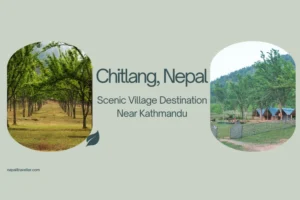Tindhare Jharana, often referred to as Bahubali Waterfall, is a stunning display of nature, located in the Roshi Rural Municipality of Kavrepalanchok (Kavre) district, Nepal. This incredible waterfall is about 300 meters high and has also gained popularity as a great destination for tourists, trekkers, and nature lovers seeking to experience adventure and beauty close to the Kathmandu valley. This blog guides you through Tindhare Jharana’s location, natural features, cultural significance, accessibility, and tourism prospects, emphasizing the prominence of this waterfall in relation to Nepal.
Table of Contents
ToggleIntroduction to Tindhare Jharana
Tindhare Jharana means “three streams waterfall” (“jharana” is waterfall in Nepali). The name is appropriate since Tindhare consists of a spurting major waterfall, which comes down from three waterfalls or ‘streams of water,’ that tumble off the cliffs of the Mahabharat mountain range in Kavre. The waterfall is located around Kaphal Danda, in Roshi municipality, and is approximately 65 to 70 kilometers east of Kathmandu. Positively, even though it has expressed as a waterfall for generations, it’s new popularity has gone viral recently after videos and photos taken by drone on social media captured the interest of many adventure seekers – even local.
The local name given to the waterfall “Bahubali Jharana” has its origins related to its distinguished three-stream fall and representation in scenes of the similar name popular Indian movie Bahubali. The waterfall is now a natural tourist attraction in Kavre due to its beautiful high plunge, wonderful greenery, and surrounding cultural highlights.
Location and Access
Tindhare Jharana is situated approximately 1800 meters above sea level in the Kavrepalanchok district which is part of Bagmati Province. It is in proximity to the Roshi River which is reached by road from Kathmandu through Dhulikhel, Namobuddha and Dapcha; the nearest significant settlements are Jaruwakhola and Falamesanghu, with a short trek of about 1 hour to the waterfall site from Jaruwakhola.
Travelers typically take approximately two hours by private vehicle from Kathmandu to Roshi Rural Municipality. The journey adds value by providing views of agricultural terra farming patterns on the east-facing slopes, verdant hills and vibrant Tamang and Newari villages along the way.
Physical and Natural Aspects
- Height and Shape: The waterfall descends roughly 300 meters, one of the taller falls in the Kathmandu valley region. It has three features which led to it being given the name “Tindhare,” with a mesmerizing, trident-like shape.
- Water Source: The water is sourced from some of the highest elevations of the Mahabharat Range and eventually belongs to the Roshi River.
- Natural Circumstances: Framed by dense forests and productive farmland, and with minimal industries nearby, the area is mostly intact and has remained in ecological equilibrium,
- Swimming and Photography: At the bottom of the waterfall, there is a pool where visitors can bathe and enjoy swimming, especially in the summer and monsoon seasons, when the water flow increases greatly. Several viewpoints and hiking paths also provide great opportunities for photography.
Cultural and Local Significance
The villages around Tindhare Jharana are primarily inhabited by the Tamang community, and have minority communities of Newari, Thakuri, Brahmin, Kami, and Damai communities. The surrounding villages and jungles provide visitors with the experience of observing how traditional Nepali rural life offers visitors authentic cultural experiences, local festivals, and food.
Hand-made Nepali drinks such as Chhyang (rice beer) and Rakshi (milled distilled alcohol) are a specialty in the area, popular for their authenticity and taste.
Notably, the area is entirely situated on fertile land and hasn’t been influenced by modern-day industry; therefore, the region can preserve its pearly landscape and cultural lifestyle.
Tourism and Activities
Tindhare Jharana is gaining in popularity for:
- Hiking & Nature Trekking: Several trails lead to the waterfall, and those trails go through nice hills, traditional villages, and nature forests. Tindhare Jharana is a great destination for hikers and nature découvries because you get the benefits of close proximity to Kathmandu, but you also get an experience that is off the beaten path.
- Picnicking and Taking Pictures: The waterfall has a peaceful and beautiful atmosphere which is great for a picnic. It has become a place where groups and families come to celebrate the day, special events, or leisure time.
- Cultural Heritage: In addition to the waterfall, tourist attractions, such as Namobuddha Monastery and the historic town of Dhulikhel, will complement your waterfall trip while also providing a mix of natural beauty and spiritual heritage.
- Adventure: The area also provides some opportunities for fresh dips and swimming in the pool below the waterfall, or discovering less disturbed areas in the cascade.
Best Time to Visit
Tindhare Jharana can be visited all year long, as it is a beautiful site year-round, but for different reasons. The following are the highlights of the waterfall for each season:
– Monsoon (June to September): During this time of year, monsoon rains swell the waterfall to a thunderous cascade, and the natural pool below the waterfall lays claim to the unpredictable tidal pool.
– Spring/Fall: Spring and fall are great times to take in the beauty of the waterfall with the exciting weather, clear skies, and nice hiking weather.
– Winter: Visiting in winter is possible, but cooler temperatures often cause the stream of water to limit.
How to Get There: Travel Guidelines
- From Kathmandu: Drive an estimated 65–70 kilometers, following the route of Dhulikhel, Namobuddha and Dapcha. The road condition varies, but it usually is accessible by a private vehicle or taxis.
- Trekking: The final portion involves about a 1 hour trek from Jaruwakhola or Falamesanghu to the waterfall. This mainly is appropriate for a moderately experienced trekker.
- Guide: It is suggested to hire local guides, as they add a different dimension to your visit with cultural stories and keep you safer on the trails.
- Facilities: There is basic local food available in villages nearby, but you may want to carry your own water and snacks.
Challenges and Conservation
As more visitations happen, it has become evident that infrastructure should have been better developed (well maintained trails, safety railings, litter disposal, etc.). The local municipality, Roshi, is trying to complete paving of trails, installing safety fences and making other improvements to better secure the visitor and protect the environment.
Conservation efforts are important to be able to maintain the ecological space and integrity of the waterfall area and surroundings with the fragile Himalayan environment and unregulated tourism practices.
Nearby Destinations
While visiting Tindhare Jharana, guests may also travel to:
- Namobuddha Monastery: A popular Buddhist pilgrimage site with amazing views of the hills and an inspiring environment.
- Dhulikhel: Known for the panoramic views of the Himalayas and situated within the cultural and wellness resorts.
- Local Villages: Home to rich Newari and Tamang culture. Visitors may experience local life by attending local festivals, observing traditional architecture, and even participating in a homestay experience.
Reasons to visit Tindhare Jharana:
- Location: Easy to get to from Kathmandu for weekend trips or day trips, avoiding long vehicle treks.
- Natural Beauty: If you dislike commercial style tourist areas, Tindhare offers a beautiful natural environment with fewer people.
- Cultural Interaction: Visitors have the opportunity to experience native communities solidly entrenched in their cultural heritage that is centuries old.
- Adventure and Relaxation: Ideal for hikers, photographers and nature lovers looking for a space that offers peace with adventure.
Conclusion
Tindhare Jharana waterfall possesses the grandeur of Nepal’s natural beauty and cultural richness. Its stunning three-tiered waterfall, abundant wildlife, and lively village life present a different experience to visitors, making it a wonderful Himalayan gem. For Nepalis and tourists, it represents nature’s beauty and the best of Nepal, located just a short drive south of the capital city.
As Tindhare Jharana gains popularity, the importance of sustainable tourism, infrastructure development, and resource conservation should be prioritized, especially in order to preserve this gem for the next generation of travelers. For travelers, whether for fun, photography, culture, or an escape, Tindhare Jharana is waiting for you with its misty canopies and rushing water.
If you are planning a visit be prepared for a trek (with many local people trekking or traveling to work), take advantage of the local hospitality along the way, and enjoy one of Nepal’s most breathtaking and developing natural attractions — Tindhare Jharana in Kavre!
Frequently Asked Questions (FAQs)
1. What is the best way to travel to Tindhare Jharana from Kathmandu?
You can travel to Tindhare Jharana from Kathmandu about 65–70 km east of Kathmandu via Dhulikhel → Namobuddha → Dapcha. Once you reach Dapcha, you can go to either Jaruwakhola or Falamesanghu, both of which are the nearest places to reach by road. From there you will need to trek about 1 hour moderately to reach the waterfall. Using a private vehicle with a driver or local jeep is most suited for this journey. Hiring the local guide is also important for the trekking part and local features and lifestyles.
2. When is the best time to visit Tindhare Jharana?
Tindhare Jharana will look beautiful at all times of the year, but the best time, again, will depend on what you want to see:
- Monsoon (June–Sept): has the most dramatic water flow, but it is mostly for photographers. The trails, be prepared, will be reduced to mud or slippery.
- Spring & Autumn: When it is clear view and good time for hiking.
- Winter: The best time to be isolated and alone, but you will have less water flow and nice temperature with bonfire!






